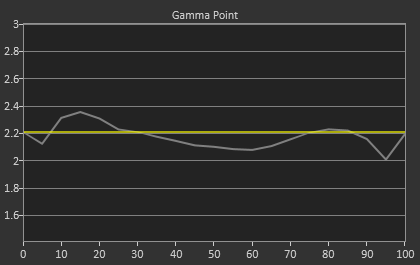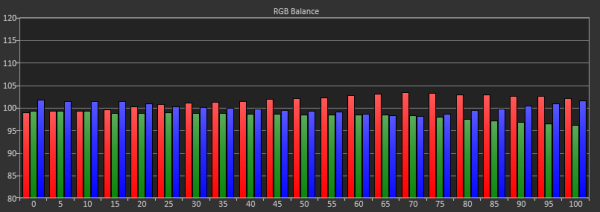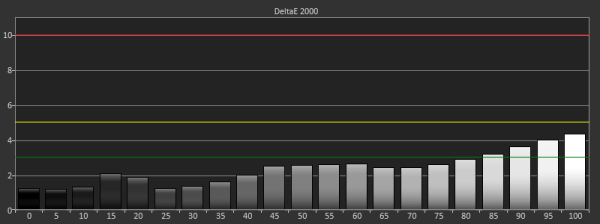LG 29EA93 Monitor Review - Rev. 1.25
by Chris Heinonen on February 12, 2013 8:49 PM ESTWith our change to CalMAN, we will also now be evaluating displays for their grayscale and gamma point. Previously we only targeted a gamma of 2.2 in calibrations but never measured it in the end. Now we will be choosing two targets in our reviews. For light output of 200 cd/m², we will target the same gamma of 2.2 right now. 2.2 gamma is still a de-facto standard, and is the standard for Apple computers and devices as well as video content. For our second calibration we target 80 cd/m² with an sRGB gamma curve. Both of these are specified in the sRGB standard, so those doing professional print or computer graphics work would likely want this.
Hopefully a display will be able to handle both of these tests, and we will also check for the grayscale quality on its own by checking 21 points, just like we do with our tablet and smartphone reviews. This will provide you with more data, as well as consistent data for the different devices.
| Pre-Calibration | 200 cd/m² Target | 80 cd/m² Target | |
| White Level | 201.5 | 198.4 | 80.1 |
| Black Level | 0.1689 | 0.1644 | 0.067 |
| Contrast Ratio | 1193:1 | 1207:1 | 1197:1 |
| Average CCT | 6545 | 6537 | 6599 |
| Gamma | 2.1648 | 2.2128 | 2.4109 |
| Average dE2000 | 2.3847 | 0.535 | 0.6238 |
Looking at the RGB Balance for the data, the pre-calibration data starts out a bit too-blue, then develops a red tint, before finally winding up with a lack of green at the top of the grayscale. The average CCT remains close to 6503K overall, but the RGB balance shows that there is a lack of correct balance in there. Looking at the post-calibrations numbers for 200 and 80 cd/m², we see almost no deviation at all in the RGB balance, which is much better. The 80 cd/m² results have a bit too much blue perhaps, but overall they're acceptable.
The pre-calibration gamma point is very close to the 2.20 target, but looking at the chart we see some issues. The gamma point rises and falls across the grayscale, which will leads to midtones and highlights not having the correct level of light output, and will lead to a less dynamic image. The overall number is good, but the chart shows that it’s not quite right. The 2.20 target for our 200 cd/m² calibration is much better, with a very linear 2.20 gamma across the whole grayscale. There are a couple small bumps in there, but nothing that would be visible in daily use.
The sRGB target is different, as the gamma isn’t linear across the whole grayscale. Instead the shadows start at 1, and it ramps up as you leave the shadows, which results in an average gamma across the grayscale of 2.40 in the end. Because of this it’s far more important to look at the actual graph than the final number, and here the LG 29EA93 does very well at tracking the target. Once calibrated, the gamma curve for the LG is very good with either sRGB or Power Law targets.

The grayscale dE2000 values takes all of this data into account. Pre-calibration, the dE2000 starts out well in the shadows, but by the end of the grayscale we have dE2000 values above 3, indicating a visible grayscale error that we can see even in motion. The average error is pretty low, but by the end it’s higher than we would like. Post-calibration, both grayscales are free of all visible error. There isn’t a single point that is above 2.0, and no one should be able to see any errors in real world use. In the end, the grayscale is basically perfect for these displays after calibration.
Pre-calibration, the LG 29EA93 is good, but not great. Post-calibration, it’s virtually perfect and will be basically free of visible errors when being used.












108 Comments
View All Comments
cheinonen - Monday, February 18, 2013 - link
You really don't want this, as while content above 235 is technically not support to exist, some does in the form of specular highlights and other very bright items. Displays or sources that automatically clip this WTW material are possibly losing some image information and shouldn't work that way.name99 - Thursday, February 14, 2013 - link
I don't want to be a dick, but the colors used in the bar charts are truly horrible --- the kind of colors that look like they are bleeding out of the bars.Please revert to the colors you used to use, or ask a designer to choose new colors (or just copy them from any piece of software that has already thought about this issue, eg the default colors used in bar graphs by Mathematica or Numbers).
Spoelie - Friday, February 15, 2013 - link
Something must be wrong with your monitor, they look fine to mebjevers - Friday, February 15, 2013 - link
I see Fry's has this monitor listed on their website. Is this the US version 1.25?http://www.frys.com/product/7511746
mcfrumpy - Friday, February 15, 2013 - link
I saw the same thing so I went to the Fry's by my place that said that had it in stock. The display model had a manufacturing date of Dec 2012 and Rev00 so I'm guessing it's the old one. My bet is the ones they are selling are older since no one else seems to have it in stock.I'll admit looking at the display model I was surprised how small it looked. For as long as it is, the height of the monitor reminds me a 21 or 22 inch monitor.
SpartanGR - Friday, February 15, 2013 - link
LG must find a way to fix this. I mean everyone will want the 1.25 version now.Dracusis - Sunday, February 17, 2013 - link
"Disabling the game mode only introduced another 1-2ms of lag, but at the expense of image quality, so I would leave it disabled."Hmm...
I'm guessing you meant something like:
"Enabling the game mode shaved off another 1-2ms of lag, but at the expense of image quality, so I would leave it disabled."
Regardless, what is this "Game mode" what what exactly does it do to the image quality?
The rest of the article was brilliant, so much detail and careful measurement. Then in one line you toss in this randomly subjective opinion and don't even qualify it when an explanation - I feel totally trolled right now.
SpartanGR - Monday, February 18, 2013 - link
I've spoken to a local seller in Korea and asked him which version they have. Had my hopes up guys but here 's his answer.Hello. Thank you for your interests
I contacted to LG, there was no official firmware update.
And the product we have in stock is the early released version.
Please feel free to ask if you have any further questions.
Thank you. Have a good day!
Best regards,
- dream-seller
Damn! i guess this is going to take a while
Wesley - Monday, February 18, 2013 - link
As others here have probably pointed out, a monitor like this has the potential to vastly improve the field of view in games, especially with some titles that may already have widescreen or multi-monitor enhancements. The images posted up comparing in-game screenshots were nice (thanks for going into that trouble), but perhaps a video demonstrating how things change on a monitor of this size would be better?For example, playing third-person games would enable a larger field of view but how does this affect the first-person perspective? Racing games all too often stretch the sides of the car when you're playing in cockpit view and the image becomes warped when playing in a multi-monitor environment. Would this screen give RTS players some advantage? Starcraft 2 can run on a MBP with the Retina display at native resolution. As a gamer myself, resolution becomes pretty important and I'm tired of 1920x1080. My only options are sinking cash into a 27" Korean monitor, a 30" monster, or something like this, which isn't that much larger but may be more beneficial.
macin - Tuesday, February 19, 2013 - link
It's 4 am and I am half asleep so bare with me here.So LG is so bothered by a review of a $700 monitor that they revise it. Great.
I am happy to hear that a company actually cares enough to seek feedback to make something better.
Why is it that the only company that line calibrates monitors is Apple?
If LG wants to stand out among other panels, why not do this for the customer as well?
Once spoiled to 2650 x 1440 and the color accuracy of Apple monitors, I can't find anything else I like.
I don't own $2k worth of calibration equip and I can't "eye" anything and get it accurate, but I know it when it see it.
I can see the difference between an out of the box pic and a calibrated pic, but I have to have someone tell me what settings they used to get there.
Maybe since you guys test so many monitors, you could add a Calibrated settings to your display page?